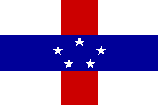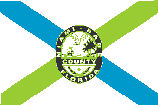- LABARUM
- A flag based on the vexillum and combining Christian symbols with those of the
Roman military, introduced by the Emperor Constantine in the early 4th Century AD, and
later used as an imperial standard (see also vexillum).
Please note - not to be confused with a cantabrian labarum
(see 'cantabrian labarum').
- LABEL
- See cadency, mark of.
![[label example]](../images/v/vxt-d595.gif)
British Royal Standard Showing the Label of HRH Princess Ann (fotw)
- LAMB OF GOD
- See agnus dei.
- LANCE
- A long light-weight spear with which some cavalry regiments were formerly
armed, and upon which the standard or guidon was also carried - now restricted
to historical or ceremonial use (see also
guidon 1) & 2),
lance flag, lance pennon 1),
staff 2)
and standard 2)).
- LANCE FLAG (or PENNANT)
- A small flag or pennant, usually swallow-tailed or triangular and of
generally simple (bicolour) design, formerly carried below the lance head by
those cavalry regiments so armed, or currently by some mounted police units in
parade dress, and now restricted to historical/ceremonial use - a lance pennon (see
also banneret 2),
pennant 2),
lance and lance pennon 1)).
![[lance flag]](../images/v/vxt-d193.gif)
![[lance flag]](../images/v/vxt-d595a.gif)
![[lance flag]](../images/v/vxt-d595b.gif)
From left: Lance Flag, British c1840; Mounted Police, New South Wales, Australia; Victoria,
Please note that the use of lance-armed cavalry and the
general design of their flag or pennant derive from Polish practice Poland having
been the country from which lance-armed light cavalry was adopted in the late 18th
century.
- LANCE PENNON
- 1)The term for an armigerous lance flag, either triangular, either
fork-tailed or square-ended according to rank, and carried by a medieval mounted knight (see also
armigerous,
banneret 2), lance,
lance flag and
pennoncier).
- 2) See lance flag.
- LANCEOLATE
- (adj) A term used that may be used to describe a rounded fly but see
ogival
(also descate,
guidon 3),
fly,
standard 4) and
standard 5)).



Examples (2); Flag of Lesna, Poland (Jarig Bakker)
Please note that the differences between ogival and lanceolate are
often very slight, and we suggest that both entries be consulted.
- LANDESFARBEN
- See 'national colours 2)' and
'state colours 3)' (also
'livery colours').
- LANGUAGE FLAGS
- See linguistic flags.
- LANGUED
- The heraldic term used when the tongue of the beast, if shown, is of different tincture
than the rest of the body (see also armed 2),
attired,
beaked,
membered and
tincture).



Flag of Φstergφtland, Sweden (fotw); Flag of Aalter, Belgium (fotw); Flag of Uri, Switzerland (fotw)
- LANYARD PENNANT
- In French Naval usage, the term and a translation of flamme de
fourragθre - for a tapered pennant in various colours, charged with the Croix de Guerre
and having a rounded (or lanceolate) fly, which is flown to indicate that a vessel has received
citations for a certain number of military decorations (see also lanceolate and
pennant 2)).
![[Lanyard pennants]](../images/v/vxt-d196.gif)
From left: 6 Citations for the Legion dHonneur, 1914-18 (fotw); 4-5 Citations for the Mιdaille Militaire 1939-45 (fotw)
- LAPEL FLAG
- 1) A metal or plastic flag sometimes showing a badge or coat of arms
below - worn on the dress or coat lapel as a patriotic or political symbol,
originally characteristic of the former Soviet Union and of the United States,
but now widely used elsewhere a flag badge or flag pin.
- 2) A paper flag see flag day 2).
- LARMES
- See gouttes.
- LATIN CROSS
- See appendix VIII.
- LAUNCHING FLAGS
- Those flags flown from a vessel that is being launched prior to fitting out,
and which in naval usage are generally (but not invariably) of a prescribed type
and sequence (see also dressing lines and
flag exchange).).
- LAY UP (or LAYING UP) COLOURS (or COLORS)
- (v) The ceremonial deposit of regimental, unit, service or national colours
in a church, cathedral or museum when they are worn out, or when the regiment
or military organisation is disbanded (see also
colour 2) and
colours 2).
- LAYERED CROSS
- A term that may be used to describe a cross whose horizontal arm differs in colour
from its vertical as in the flag of the Netherlands Antilles (see also cross 1),
layered saltire and trinitarian cross).



Flag of the Netherlands Antilles (fotw); Former Flag of The Canada Steamship line (fotw); Flag of Belov, Czech Republic (fotw)
Please note that this term has been introduced by the
Editors as no established alternative could be found.
Also please note that this term should only be used in the
description of flags as illustrated above, and does not include crosses which show two colours
because of a fimbriation, or are divided in ways other than those shown.
- LAYERED SALTIRE
- A term that may be used to describe any saltire where an arm of one colour overlays (or
apparently overlays) an arm of a different colour as in the examples given below (see also
layered cross and saltire.




Flag of Rubi, Spain (fotw); Flag of Hornν Cerekev, Czech Republic;
City of Alfarrΰs, Spain (fotw); Flag of Miami-Dade County, Florida, USA (fotw)
Please note that this term has been introduced by the Editors
as no established alternative could be found.
Also please note that this term should only be used in the
description of flags as illustrated above, and does not include saltires which show two
colours because of a fimbriation, or are divided in ways other than those shown.
- LEADING EDGE
- An alternative term for the dexter edge of a vertically hung banner or a gonfalon see
dexter edge.
Please note, that this term has been introduced by the Editors
as a vexillogical alternative to the heraldically derived dexter edge.
- LEECH
- The edge of a sail that lies opposite to its yard, and is used (in place of at the peak on
gaff-rigged vessels) to indicate the position of an ensign when flown from a halyard running from
the outer end of the mainsail boom to the mast of a Bermuda rigged sailing yacht - instead of from
an ensign staff at the stern (see also
ensign 1),
gaff,
halyard,
peak and
yard).


Ensign Flown From The Leech: Ensign At The Peak
- LEISURE ENSIGN
- See yacht ensign under ensign.
- LEGGED
- See membered.
- LENGTH
- 1) That dimension of a flag which is measured horizontally from the outside
edge of the hoist (generally excluding the heading), to the opposite extreme edge
of the fly (see also Appendix I,
width, heading,
hoist and fly).
- 2) The longer dimension of a stripe or band within a flag howsoever orientated
(see also stripe).
- 3) The dimension of an emblem, charge, arms, shield or badge measured horizontally,
when it appears on a flag but see the note below, height
and width across (see also badge,
charge, emblem
'establishment of arms'
and shield).

Please note that definition 3) is given with regard to the consistent
use of proportions when describing a flag and its charges, however, it is suggested that when
giving the actual dimensions of any such charge the phrase width across should be used for its
horizontal measurement and the word height for its vertical size (see also
dimensions and
proportions).
- LESSER ARMS
- See under arms.
- LETTER OF MARQUE
- See privateer(s).
- LIGATURE
- See monogram.
- LINED
- 1) See edging 1).
- 2) A term sometimes used to describe the detail lines within a charge
or a figure but see garnished and
masoned (also charge 1).
- 3) In heraldry a term for the lining (either fur or fabric) of a mantle or pavilion, or if a
bear or greyhound has a line affixed to its collar (see also mantle
and pavilion).
- LINGUISTIC FLAGS
- 1) Flag-like images that are intended to link together communities which speak the same language
irrespective of national boundaries, and which are usually an amalgam of the national flags concerned.
- 2) Flags that are intended to represent a link through the use of a common natural language,
generally (but not invariably) countries previously held by colonial ties such as that of the Francophonie.
- 3) Flags that are intended to represent one of the constructed languages, for example Esperanto.
- 4) Flag images, usually (but not invariably) those of national flags, which are used on the Internet
(and on other documentation) to indicate in which languages the material on a particular site are available
for the convenience of the reader.


Amalgam Language Flags for English and German (CS)


From left: Flag of the Francophonie; Esperanto flag (fotw)
Please note with regard to 1) that these images do not (as far as is known) exist in cloth.
- LIVERY BANNER
- The term, now obsolete, for a small square flag in the deceased persons livery colours,
usually for use at that persons funeral (see also
badge banner,
livery colours,
great banner,
grumphion and
bannerole).
- LIVERY COLOURS (or COLORS)
- The principal colours (often - but not exclusively - usually the first metal and first tincture) of a coat of arms
and generally shown as two or three stripes on flags (see also
state colours 3),
coat of arms 2) and
rule of tincture).
- 2) The principal colours of a flag unrelated to a coat of arms - see
national colours 2).
![[Livery colour example]](../images/v/vxt-d197.gif)
![[Livery colour example]](../images/v/vxt-d197a.jpg)
![[Livery colour example]](../images/v/vxt-d197b.gif)
Arms and Flag of Cerklie na Gorenjskem, Slovenia (fotw); The State Arms and
National Flag of Germany (fotw)
Please note that the term is derived from the colours usually
taken from a familys arms - worn as a livery by the servants of that family.
- LOGO
- 1) A design serving as the symbol of a commercial enterprise or educational
establishment, or other entity, that is not a coat of arms, seal, badge or emblem as
defined herein (see also badge 1) &-3),
coat of arms,
corporate flag,
all entries under emblem,
house flag 1),
institutional flag, official,
institutional flag, unofficial and
">seal.
- 2) A simplified version of an existing badge or of an emblem that is often
used in lieu of these for the same purpose.
![[logo flag]](../images/v/vxt-d586.gif)
Flag of the Portuguese Railway Company (fotw)
- LOGO ON A BEDSHEET (or LOB)
- A derogatory term that is intended to describe any flag bearing an emblem,
badge, seal, shield or arms upon a plain field a bed sheet flag or building
site flag but see
armorial flag,
armorial ensign and
seal flag (also
armorial bearing,
badge 1) - 3),
coat of arms 2), all entries under
emblem, logo,
plain 2)
seal,
and shield 1)).
- LONG CROSS
- See Latin cross in appendix VIII.
- LOOP (or LOOP, THE)
- See flag adjutant.
- LOWER FLY (or LOWER FLY CANTON)
- In vexillology a term for that quarter of a flag which occupies the lower fly -
the fourth or lower fly canton (see also 'canton 3)' and
'fly').
- LOWER HOIST (or LOWER HOIST CANTON)
- In vexillology a term for that quarter of a flag which occupies the lower hoist, -
the third or lower hoist canton (see also canton 3) and
hoist 1)).
- LOWERED
- See abased.
- LOZENGE
-
- The heraldic term for a diamond-shape a rhombus - but see fusil
(also lozengy, lozengy bendy
and mascle).
Please note however, that in heraldry the lozenge
is also the escutcheon upon which a womans coat of arms is placed (see also
armorial bearings,
escutcheon and
coat of arms).
- LOZENGE-VOIDED
- See mascle
.
- LOZENGY
- 1) In heraldry, a term for when the field of a banner of arms or shield is covered
with lozenges or diamonds in alternating colours fusilly (see also banner,
fusil,
lozenge above and
lozengebendy below).
- 2) In vexillology as above, however, the term may also be applied to a field covered with lozenges or
diamond shapes set at an angle see lozengy bendy below.


Slocum Society International (CS); Banner of Arms 18th Century, Monaco (fotw)
Please note however, that on flags this term may also be
applied to a field covered with lozenges or diamond shapes set at an angle such as those
on the flag of the German state of Bavaria, whereas in heraldic practice these would be
lozengy bendy (or bendy sinister).
![[a Lozengy flag]](../images/v/vxt-d200.gif)
The Arms and Flag of the State of Bavaria, Germany (fotw)
- LOZENGY BENDY (or BENDY SINISTER)
- The heraldic term used when the field of a shield or banner of arms is covered with lozenges
or diamond shapes in alternating colours and set at an angle fusilly bendy or bendy sinister
see bendy and bendy sinister in appendix VI
(also banner 1),
fusil,
lozenge and lozengy 1) above).
![[label example]](../images/v/vxt-d595.gif)
![[lance flag]](../images/v/vxt-d193.gif)
![[lance flag]](../images/v/vxt-d595a.gif)
![[lance flag]](../images/v/vxt-d595b.gif)






![[Lanyard pennants]](../images/v/vxt-d196.gif)







![[Livery colour example]](../images/v/vxt-d197.gif)
![[Livery colour example]](../images/v/vxt-d197a.jpg)
![[Livery colour example]](../images/v/vxt-d197b.gif)










![[logo flag]](../images/v/vxt-d586.gif)
![[a Lozengy flag]](../images/v/vxt-d200.gif)